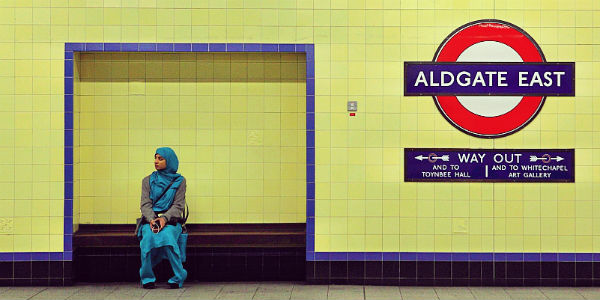What the ECJ’s ruling on headscarves means (and why it may be tough to enforce)
The European Court of Justice’s ruling this week does not ban employees from wearing headscarves at work, contrary to some media coverage. Rather, it allows bosses to ban them – along with other symbols of religious belief – if the job is customer-facing and the workplace has a neutrality policy. Steve Peers predicts that such bans may prove difficult to comply with, especially since the European Court of Human Rights has previously ruled that in some cases staff do have the right to wear religious symbols.

Photo: Roberto Trombetta via a CC-BY-NC 2.0 licence
When can employers ban their staff from wearing headscarves? The European Court of Justice’s ruling has attracted a lot of attention, some of it confused. I have written before about the background to the cases, and about the non-binding opinions of Advocates-General, and there will hopefully be further more analytical pieces about today’s judgments to come. But this post is a short explanation of the rulings to clear up any confusion.
Background
The EU has long had laws on sex discrimination, and discrimination regarding EU citizens on grounds of nationality. Since 2000, it has also had laws against race discrimination and also a ‘framework directive’ against discrimination at work on grounds of disability, age, sexual orientation or religion. The ECJ has often been called upon to rule on the first three of those grounds, but today’s two judgments (G4S v Achbita and Bougnaoui) are the first time it has been asked to rule on non-discrimination at work on religious grounds.
EU law does not generally apply to other aspects of religion, except that EU law on asylum applies to people who have been persecuted on religious grounds. So today’s judgments are not relevant as regards regulating religion in education, for instance.
It should also be noted that the European Convention on Human Rights (ECHR) protects the freedom of religion. The European Court of Human Rights – a separate body – has previously ruled on how that freedom applies in the workplace, concluding that in some cases employers must allow employees who wish to wear religious symbols (see Eweida v UK, for example) to do so.
The rulings
The G4S ruling is the more significant of the two cases, in which the ECJ’s reasoning is most fully set out. First the Court rules that clothing worn for religious reasons is an aspect of religious belief. Then it concludes that there was no direct discrimination (ie discrimination purely on religious grounds) against Ms Achbita, who was not allowed to wear a headscarf when dealing with customers, because her employer had a general ban on any employee display of religious or political belief.
Next, the ECJ ruled on whether there was any indirect discrimination (ie discrimination not on religious grounds, but which affected people of a particular religion more than others). Such discrimination can be ‘objectively justified by a legitimate aim…if the means of achieving that aim are appropriate and necessary.’ In the Court’s view, the national court which had asked the ECJ these questions should consider that an employer’s ‘neutrality’ policy regarding customers was ‘legitimate’, and was part of its ‘freedom to conduct a business’.
However, such as policy had to be ‘systematic’ and ‘undifferentiated’ as regards different beliefs. It also should be considered whether it was limited to those workers who ‘interact with customers’, and whether it would have been possible to reassign the employee to a different role without ‘visual contact’ with customers, without the employer taking on an extra burden.
In the second case, the Court ruled that employers could not discriminate due to a customer request that employees not wear a headscarf. This was not ‘a genuine and determining occupational requirement’ that could justify reserving a job to those who did not wear headscarves.
Summary
The ECJ’s rulings must be applied by the two national courts that requested it to rule. They are also binding more generally on the courts of all 28 EU Member States.
In principle the rulings mean that employers may ban employees from wearing headscarves, but only in certain cases. First of all, the cases only concern customer-facing employees, on condition that the employer has a ‘neutrality’ policy. The ECJ was not asked to rule on other groups of employees, but its rulings indicate that it would be more difficult, if not impossible, to justify bans in those cases. Nor was it asked to clarify further what a ‘customer-facing’ employee is exactly.
A neutrality policy mean an employer also has to ban other religious or political symbols worn by customer-facing employees. So no kippas, no crucifixes, no turbans – and no icons of Richard Dawkins either. This could be rather awkward in light of the human rights case law referred to above, which says wearing crucifixes (for instance) is sometimes an aspect of an employee’s right to manifest her freedom of religion.
There is a thin line between saying that employee headscarves can’t be banned just because customers ask for it on the one hand, and allowing employers to ban such clothing in effect due to anticipation of customer reaction. In practice this might prove something of a legal fiction.
The bottom line is that today’s judgments do not constitute a ‘workplace headscarf ban’, but merely permit employers to establish such a ban – subject to limits which might prove difficult to comply with in practice.
Barnard & Peers: chapter 9, chapter 20
This post represents the views of the author and not those of Democratic Audit. It first appeared at the EU Law Analysis blog.
Steve Peers is Professor of Law at the University of Essex.





 Democratic Audit's core funding is provided by the Joseph Rowntree Charitable Trust. Additional funding is provided by the London School of Economics.
Democratic Audit's core funding is provided by the Joseph Rowntree Charitable Trust. Additional funding is provided by the London School of Economics.